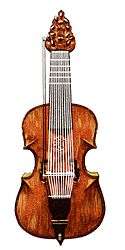Lirone
The lirone (or lira da gamba) is the bass member of the lira family of instruments that was popular in the late 16th and early 17th centuries. It is a bowed string instrument with between 9 and 16 gut strings and a fretted neck. When played, it is held between the legs in the manner of a cello or viol (viola da gamba).
 | |
| Other names | Lira da gamba; lyrone; lyra da gamba |
|---|---|
| Classification | |
| Related instruments | |
It was used in italian operas and oratoriums to accompany the human voice, specially the gods. Because the lira da gambe can not play the bass, there must be a bass instrument, theorbo, harpsichord or viola da gamba.
The sources describe, that the instrument was used for the special sound, although it is an imperfect instrument.
Important is, to pay attention to the minor or major terz.
Description
The Grove Dictionary of Music and Musicians describes the lirone as essentially a larger version of the lira da braccio, which has a similar wide fingerboard, flat bridge, and leaf-shaped pegbox with frontal pegs.[1] Its flat bridge allows for the playing of chords of between three and five notes.
History
The lirone was primarily used in Italy[2] during the late 16th and early 17th centuries (and particularly in the time of Claudio Monteverdi) to provide continuo, or harmony for the accompaniment of vocal music. It was frequently used in Catholic churches, particularly by Jesuits.[3]
Performers
Despite the resurgence in Baroque instrument performance during the 20th century, only a handful of musicians play the lirone. Notable performers on the instrument include Erin Headley of England, Imke David (Weimar), Claas Harders and Hille Perl of Germany, Annalisa Pappano of the United States, Laura Vaughan of Australia, and Paulina van Laarhoven of the Netherlands.[4][5][6][7]
See also
- Lira da braccio
- Viol
- Violone, a contrabass instrument of the viol family
References
- Grove Dictionary of Music and Musicians, ed. L. Macy (accessed 11 November 2006)
- Pio Stefano (2012). Viol and Lute Makers of Venice. Venezia, Italy: Venice research. p. 441. ISBN 9788890725203. Archived from the original on 2018-03-13. Retrieved 2020-02-28.
- "Baroque Musical Instruments". Catacoustic Consort. Archived from the original on 19 December 2012. Retrieved 14 December 2012.
- Grove Dictionary of Music and Musicians, ed. L. Macy - Erin Headley, "Lirone"
- Claas Harders
- Laura Vaughan
- Paulina van Laarhoven
Sources
- Erin Headley. "Lirone", Grove Music Online, ed. L. Macy (accessed November 11, 2006), grovemusic.com (subscription access).
- John Weretka. "Homer the lironist: P.F. Mola, Art and Music in the Baroque"
- Imke David "Die sechzehn Saiten der italienischen Lira da gamba", orfeo Verlag, 1999, ISBN 3-9806730-0-6
External links
- Article
- Photo of Annalisa Pappano with a 14-string lirone
- Photograph of a lirone
- Henner Harders - Lirone maker
Listening
- Lirone audio (track 3 features the instrument accompanied by a plucked string instrument; tracks 1, 2, 5, 6, 7, and 10 feature the lirone in an accompanying role)
- Lirone audio